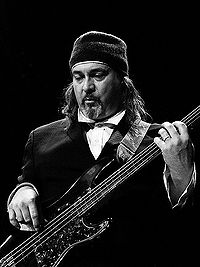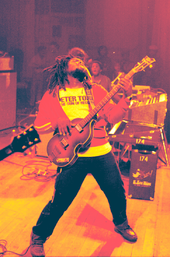Rhythm Killers
Sly and Robbie enlisted producer Bill Laswell and an ensemble of musicians to record the album at the Quad studio in New York City.
[1] After Island founder and executive Chris Blackwell hired them to work with singer Grace Jones, the duo developed a more sparse, robotic production style with funk and dub influences.
[2] They branched out into cross-genre experiments with a conceptual, ensemble-oriented approach,[3] while developing a mentorship with record producer Bill Laswell,[4] whom they met through Blackwell and by working on Mick Jagger's 1985 album She's the Boss.
[2][4] In 1985, they collaborated with Laswell on their album Language Barrier, which had guest contributions from Herbie Hancock, Bob Dylan, Afrika Bambaataa, and Manu DiBango.
[9] After releasing The Sting (1986) and Electro Reggae (1987) as members of their Taxi Gang band, Sly and Robbie enlisted Laswell again to work on Rhythm Killers.
[6][10] Before entering the studio, Sly and Robbie originally had planned music and demos to work with, but scrapped them after Chris Blackwell of Island discouraged the idea.
[4] Despite his eclectic output, Laswell himself had started out as a bass player in funk groups, an experience that inspired him to compose his musical arrangements with a rhythmic foundation.
"[6] Along with live percussion, Dunbar played Simmons drums, and the duo integrated contemporary electronic music technology such as the Fairlight CMI synthesizer in the album's recording.
Rhythm Killers is characterized as a work of funk music by Musician magazine's Alan di Perna,[6] while Stereo Review critic Phyl Garland called it a dance album.
[11] Although it is not a reggae album, Rhythm Killers exhibits Sly and Robbie's Taxi Records production aesthetic,[13] which drew on their cultural connection to Jamaican dance halls and their collective interest in experimental electronic sounds.
[1] Incorporating mechanized beats, rocksteady tempos, and sinuous bass, the aesthetic presaged ragga music and the rise of digital instrumentation in reggae during the 1980s.
"[24] Mat Smith from Melody Maker said the enthusiastic music was driven by a "schizophrenic art of noise attack all lashed around a nonstop rhythm that bumps each track nose to tail tight.
"[25] According to the Spin Alternative Record Guide (1995), Rhythm Killers "truly broke ground" after the experimentation on Language Barrier and served as "the story of late-20th-century black music done as symphony.
"[27] Mike Joyce of The Washington Post found it "more punchy and elastic" than Language Barrier and felt "the accent is still on electronic rhythms, but the mood is vibrantly expansive".
[29] He characterized the duo as a "world pop" rhythm section and said their style is complemented by "a chauvinistic variation on Bill Laswell's usual international brigade".
[30] John Leland argued that the album is "the continuous synthesis that Laswell promised on Herbie Hancock's 'Rockit'", "extended in both length and scope", as it features "a knack for unexpected juxtapositions and no respect for artificial boundaries.
It features vocals by Shinehead,[32] whose rap begins with a Howard Cosell impersonation,[22] and Bootsy Collins, who advises listeners that "you have one desire and that's to dance until you drop.
"[40] In Rolling Stone, Gavin Edwards called it "a thirty-five-minute dance party full of surprises and strange noises", writing that it "sounds like the Great Missing DJ Set—albeit one played by live musicians with perfect telepathy.
[17] In a negative review, Greg Taylor of The Sydney Morning Herald criticized the music as "wallpaper" undermined by a gaudy hip hop production.
[58] Shinehead's own appearance on the album bolstered his mainstream exposure as he was receiving American radio airplay with his debut single and performing on an international tour.
[3] In retrospect, culture critic Mark Anthony Neal deems Rhythm Killers an essential album of 1980s underground funk,[20] while reggae historian Steve Barrow cites it as one of the most engaging projects Sly and Robbie were involved in during the 1980s.
[34] The State writes that on albums such as Rhythm Killers, they frequently attempted to broaden the role of their instruments and consequently took bass and drums to "unexplored rhythmic frontiers".
"[3] In The Rough Guide to Rock (2003), Peter Shapiro cites the album as Laswell's "best outside production" and one that "fulfilled his fusion/fission concept ... in which some of the finest dance musicians in the world jam on two side-long grooves that imply New Orleans R&B, 70s funk, hip-hop and ragga are all part of the same continuum.
"[26] AllMusic editor Stephen Cook is less enthusiastic and calls it "a valiant venture gone awry", believing that the songs are monotonous and comprising "one tired electronic groove after another".



